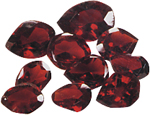OTHER GARNET
TYPES
Garnets occur in every color
except blue. A hundred years
ago, various types of colored
garnets made up over half the
items displayed in the windows
of European jewelers. Nowadays,
many gemstones undergo heat
or impregnation treatment,
but the garnets-along with
diamond, alexandrite, cat's
eye chrysoberyl, and peridot-
are valuable gemstones that
are beautiful without any treatment. |
 |
Weight : 0.91
ct
Size (mm): L 6.7 x W 5.1 x
D 3.07
Untreated
US $6,000 |
Demantoid Garnet
Demantoid is a green garnet
with diamond-like scintillation
that was mined in the Ural
Mountains of Russia from
the 1860s. In its day, this
gemstone was popular in Europe
and the United States, but
mining operations were suspended
in 1917 as a result of the
Russian revolution. Mining
has gradually resumed since
the Soviet perestroika movement
of the late 1980s. Some of
the older demantoids re-enter
the market through auctions
and achieve prices of more
than $10,000 per carat. Compared
to tsavorite, demantoid's
color is strongly yellowish.
Of all the traditional gemstones,
only demantoid has stronger
dispersion than diamond. This
strong dispersion is the source
of its unique beauty. Demantoid
also has a relatively high
refractive index of 1875.
Other sources of demantoid
garnet include Italy and southwestern
Africa. |
|
|
Mandarin Garnet
One of the numerous colored garnet
varieties is this one with a mandarin
orange color, which first appeared
on the market in1992. These mandarin
garnets are mined in northwestern
Namibia in Africa, where the typical
rough reportedly occurs as 24-sided
crystals ranging from 2 to 25 millimeters
(.08 to .98 inch). The photograph
shows an especially transparent
mandarin garnet with a beautiful
tangerine color. When viewed with
a 10-power loupe, billowing veil-like
inclusions can be observed throughout
the stone, a characteristic typical
of this material. |
Rough
Weight : 2.19 ct
Size (mm): L 6.2 x W 5.9 |
 |
 |
Weight
: 1.65 ct
Size (mm): L 7.9 x W 6.1 x D
4.11
untreated
US $1,200 |
 |
10 pc
Total Weight: 1.15ct
Untreated |
Pyrope Garnet
Pyrope garnets occur in small sizes.
The jewelry that was extremely
popular among the bourgeoisie of
19th-century Europe often contained
these small pyrope garnets. Pyrope
has a fiery red color, but much
of the rough material is nearly
black, so transparency is improved
by cutting a large table and a
shallow crown to prevent finished
stones from becoming too dark.
The Czech province of Bohemia was
the main source of pyrope from
the early 16th century until the
late 19th century. |
|
 |
JUDGING QUALITY
Gem-quality tsavorite is highly transparent,
with an especially attractive mosaic
pattern of contrasting tones of
green, a tone level of 4 to 6,
and a beauty grade of S or A. Gem
qualities of three or more carats
are expensive because of limited
production. This is in contrast
to the ease with which a ten-carat
reddish almandite, another type
of garnet, can be found.
There are cultural and personal differences
as to whether a darker (tone 5 or
6) or lighter (tone 3 or 4) stone
is preferred, but it is imperative
that the tone level matches the jewelry
being made. Any stone with a beauty
grade of S will sparkle beautifully.
If more people come to prefer tone
level 3, demand for those stones
will become that much higher, making
them more rare. The ranges of the
three quality zones are not absolute,
and may change with the times. |
|